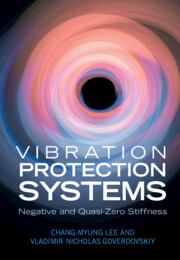Book contents
- Vibration Protection Systems
- Vibration Protection Systems
- Copyright page
- Contents
- Preface
- Acknowledgments
- Glossary
- 1 Vibrations Destroying Human–Machine Systems Inside and Outside
- 2 Vibration Protection Systems with Negative and Quasi-Zero Stiffness
- 3 Modeling of Elastic Postbuckling in Large and Dimensioning the Mechanisms with Negative Stiffness
- 4 The Type and Number Synthesis of Function-Generating Mechanisms
- 5 Dynamics of Systems with Sign-Changing Stiffness
- 6 Dynamics of Systems with Sign-Changing Stiffness
- 7 Dynamics of Systems with Sign-Changing Stiffness
- 8 Methods of Experimental Study of Vibration Protection Systems with Negative and Quasi-Zero Stiffness
- 9 In Harmony with Conventional Vibration Protection Systems
- 10 Development and Use of Vibration Protection Systems with Negative and Quasi-Zero Stiffness
- Index
- References
6 - Dynamics of Systems with Sign-Changing Stiffness
Damping Control
Published online by Cambridge University Press: 29 October 2021
- Vibration Protection Systems
- Vibration Protection Systems
- Copyright page
- Contents
- Preface
- Acknowledgments
- Glossary
- 1 Vibrations Destroying Human–Machine Systems Inside and Outside
- 2 Vibration Protection Systems with Negative and Quasi-Zero Stiffness
- 3 Modeling of Elastic Postbuckling in Large and Dimensioning the Mechanisms with Negative Stiffness
- 4 The Type and Number Synthesis of Function-Generating Mechanisms
- 5 Dynamics of Systems with Sign-Changing Stiffness
- 6 Dynamics of Systems with Sign-Changing Stiffness
- 7 Dynamics of Systems with Sign-Changing Stiffness
- 8 Methods of Experimental Study of Vibration Protection Systems with Negative and Quasi-Zero Stiffness
- 9 In Harmony with Conventional Vibration Protection Systems
- 10 Development and Use of Vibration Protection Systems with Negative and Quasi-Zero Stiffness
- Index
- References
Summary
The systems with negative and quasi-zero stiffness can provide perfect vibration protection in a wide frequency range including near-zero values. However, it is possible under a certain structure of system damping. Intelligent design approaches are presented to control the structural (hysteretic) components in thin-walled elastic elements and slip ones in movable joints of the mechanisms structuring the vibration protection systems with small stiffness. These involve (a) models for analysis and optimization of the components, (b) novel antifriction materials and composites providing reducing the hysteretic and kinetic frictions up to 0.02 to 0.005, which are adozen times less than using most prevalent materials. For instance, synthesized incompressible lubricants and solid lightweight composites provided a little to no hysteretic friction in the elements designed as the packages of thin plates, and no kinetic friction in the insert liners and guiderails. The use of approaches reduced at least 3.5 to 4 times unwanted level of system damping. These approaches can provide even more drastic, 0.01 to 0.02, decrease in the system damping. Assuming active motion control, this will reduce the system natural frequencies up to 0.15 to 0.2 Hz and improve vibration protection 50 to 300 times and more.
Keywords
- Type
- Chapter
- Information
- Vibration Protection SystemsNegative and Quasi-Zero Stiffness, pp. 145 - 171Publisher: Cambridge University PressPrint publication year: 2021

